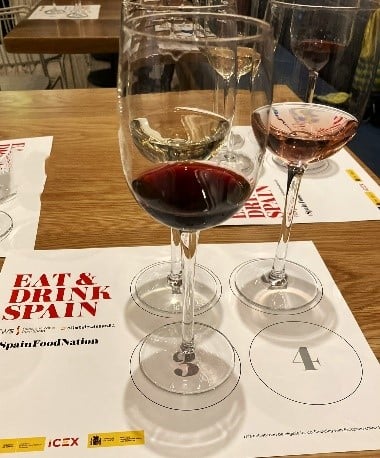Grapes Arrive
It was during this period that they established the city of Gadir (modern-day Cadiz) on the picturesque southwest coast of the Iberian Peninsula. As they ventured further into this region, the Phoenicians brought with them amphorae, clay pots used to transport and store various goods, including wine.
What drew the Phoenicians to this part of the world was the striking resemblance between the soil, climate, and geography of the Iberian Peninsula and their homeland in the Middle East. It was a discovery that held great promise, for they saw the potential for cultivating grapes and producing wine locally because their reliance on amphorae for transporting wine had its drawbacks; these containers were prone to leakage and breakage during the often-treacherous sea voyages.
To overcome the logistical challenges of amphorae, the Phoenicians decided to plant grapevines in the fertile and sun-soaked lands around Gadir, marking the inception of local wine production in the region. As the vineyards flourished, they began to yield sweet, hard-shelled grapes that were highly sought-after for winemaking during that era. Over time, this region’s viticulture evolved and matured, eventually giving birth to what we now know as the Sherry wine region. The unique characteristics of the grapes grown in Gadir, combined with winemaking techniques that developed over the centuries contributed to the distinctive flavors and qualities associated with Sherry wines.
More Vines Delivered
Following in the footsteps of the Phoenicians, the Carthaginians arrived on the Iberian Peninsula with Cartagena being the notable city they founded. Their presence further enriched the cultivation of grapes and winemaking in the region. Around 1000 BC, the Romans expanded their dominion to encompass a significant portion of Spain and they planted vines for wines to sustain their soldiers and their settlements. They even hollowed out stone troughs to ferment the wine and improved the quality of the amphorae. This expansion brought with it the widespread planting of grapevines and the introduction of advanced viticultural practices and wine production centered on two provinces, Baetica (corresponding to modern-day Andalusia) and Tarraconensis (now Tarragona).
Muslims Review Grape Production
The Moors, Muslim inhabitants of North Africa, established a significant presence in the Iberian Peninsula (modern-day Spain and Portugal) following the Islamic conquest of 711 AD. The Islamic culture and law had a significant influence on the region during this period, including dietary and drinking habits; however, their approach to wine and alcohol was nuanced. Islamic dietary laws, as outlined in the Quran, generally prohibits the consumption of alcoholic beverages, including wine. The prohibition is based on religious beliefs and principles, resulting in restrictions on the production, sale, and consumption of alcoholic beverages, including wine.
While the Quran explicitly prohibits the consumption of wine and intoxicants, the application of these prohibitions can vary among Muslim communities. During the rule of the Moors in the Iberian Peninsula, there was no universal or consistent ban on wine production. The extent and strictness of prohibitions on wine and alcohol varied, based on local rulers, the interpretation of Islamic law, and the specific historical context.
Franco’s Influences on Wine
From 1936-1939 (the Spanish Civil War) and the years following the rule of General Francisco Franco, wine-making was heavily regulated and often production and distribution were controlled by the state. The government controlled the industry so that it served the interests of the regime by establishing regulations and controls including the creation of the Spanish Wine Institute (Instituto Nacional de Denominaciones de Origen/ INDO) in 1934. The mission was to regulate wine quality and protect regional designations of origin (Denomininacion de Origen) which are still in place today. Winemakers had to follow strict standards and could not produce wine that did not meet these regulations.
The Phylloxera Epidemic
In the late 19th century, Spain, like many other wine-producing regions around the world, faced a devastating vineyard pest known as phylloxera. To combat this insect, which threatened the very existence of grapevines, some regions resorted to uprooting vineyards and temporarily discontinuing wine production. This wasn’t a matter of legality but rather a response to a natural disaster that affected the wine industry.
Finally, the 1970s
Since the 1970s Spain has undergone significant changes and has transitioned from being primarily known for producing bulk and low-quality wines to becoming one of the world’s leading wine-production and exporting countries supported by investments in modern winemaking techniques and the adoption of better grape-growing practices.
The Denominacion de Origen (DO) system started in the 1930s and gained significance as it defined specific wine regions with unique characteristics, grape varieties, and production standards – all important in promoting the quality and authenticity of wines from Spain. Improved technology includes temperature-controlled fermentation and better equipment.
While winemakers have also been experimenting with international grape varieties including Cabernet Sauvignon, Merlot, and Chardonnay there has been a resurgence in native grape varieties such as Tempranillo, Garnacha and Alberino.
Economic Impact
Spain is a major participant in the global wine market and has a strong presence in Europe, the United States, and Asia. Spain boasts the largest stretch of vineyards with a remarkable expansion in the past five years where more than 950,000 hectares have been dedicated to vine cultivation. This success has attracted significant foreign investment with the sector receiving 816.18 million Euros from international sources in the last decade. Hong Kong stands out as the primary investor, contributing 92 percent of the investments in the sector in 2019.
Spain holds the distinction of being the world’s third-largest wine producer with an extensive presence in 60 distinctive regions and Denominations of Origin (DO). Notably, Rioja and Priorat are the sole Spanish regions that qualify as DOCa, signifying the highest standard of quality within a DO.
In 2020, Spain’s wine production reached an estimated 43.8 million hectoliters (International Organization of Vine and Wine/OIV). The value of Spanish wine exports amounted to approximately 2.68 billion Euros (Spanish Wine Market Observatory).
In 2021 the Spanish wine market continued to thrive with a valuation of $10.7 billion and projected growth at a Compound Annual Growth Rate (CAGR) exceeding 7 percent. Among the various wine categories, still wine remained the largest while sparkling wine was poised to register the fastest growth in terms of value. The on-trade distribution channel holds the largest share and glass packaging remains the most commonly used material. Madrid emerged as the largest wine market in the country.
The Grapes
Rioja
The Rioja Designation of Origin (DO) includes 54,000 hectares of vineyards in the northern regions of Spain, spanning La Rioja, the Basque country, and Navarre. The region is celebrated as one of Spain’s most iconic wine-producing areas. At the heart of the region lies the Tempranillo grape which is carefully nurtured and aged in oak barrels that produce some of the most elegantly sophisticated and internationally renowned wines in all of Europe
Priorat
The Priorat wine region is located in Catalonia, a center for low-yield viticulture where the vineyards cling to steep, rocky hillsides, positioned 100-700 meters above sea level. In these extreme conditions the vines struggle to thrive, producing grapes with remarkable intensity and concentration. The wines produced are full-bodied reds that deliver depth and character.
Regulatory Changes
The Spanish wine industry has introduced new classifications and regulations to adapt to changing trends and to accommodate a wider range of wines. Vino de la Terra and Vine de Mesa offer flexibility in categorizing wines based on geographical and quality considerations while the Vinicola de Espana classification allows for the recognition of high-quality wines that do not fit within the traditional DO systems, thereby promoting excellence in Spanish winemaking.
In My Opinion
Evan Goldstein recently presented wines at the Foods and Wines from Spain event in New York City:
- Mazas Garnacha Tinta 2020.
Wine crafted from Tinto de Toro, a unique Spanish clone of Tempranillo, complemented by 10 percent Garnacha; honored with the prestigious Decanter World Wine Award, Best in Show (2022).
Bodegas Mazas is dedicated to the pursuit of crafting innovative and premium wines. They achieve their objective through the skillful use of modern technology in their winery located in Morales de Toro. All the grapes utilized in their winemaking process are sourced from their vineyards in the Toro Designation of Origin (DO). The estate boasts four distinct vineyards scattered across the Toro region of Castilla y Leon. Two of these vineyards are more than 80 years old while the other two are over 50 years old. In total, the vineyards encompass 140 hectares; however, Bodegas Mazas selects grapes from a limited number of the finest old vine parcels to create their wines.
The region’s climatic conditions are characterized by low precipitation and the constant challenges posed by infertile soil and extreme temperature fluctuations. These conditions produce wines with intense color and fruit flavors.
Notes:
Mazas Garna Tinta 2020 presents an enchanting appearance, with its deep, burgundy red hue gradually transitioning to a delicate pink rim. The bouquet is a vibrant medley of luscious ripe cherries, complemented by a symphony of flavors, including floral hints, succulent black plums, ripe strawberries, and delicate spice nuances harmoniously interwoven with earthy undertones. The wine delivers a luxurious and velvety texture that persists to a finish graced with a pleasing earthy essence.
2. Coral de Penascal Ethical Rose.
100 percent Tempranillo. Castilla y Leon, Spain. Vegan, Certified Organic. Sustainable. Each bottle contributes to the restoration of coral reefs which represent 25 percent of biodiversity.
Hijos de Antonio Barcelo is a prestigious bodega with a legacy that started in 1876. The rich heritage combined with modern practices results in a wine that is both timeless and innovative. The winery is carbon neutral, reducing its carbon footprint and environmental impact. The wine is packaged in materials that are gentle to the earth and the ultralight bottle minimizes the ecological footprint.
Notes:
Coral de Penascal Ethical Rose is a wine that captivates the senses. Its crystal-clear appearance reveals a delicate coral hue that is as enticing as it is inviting. The bouquet is a symphony of fragrances, where vibrant red currants and raspberries take center stage, harmoniously intertwining with the luscious notes of stone fruits, reminiscent of ripe peaches. These fruit-forward scents are gracefully complemented by a subtle backdrop of white flowers.
Upon sipping this exquisite rose, the palate is treated to a medley of flavors that mirror the aromatic promise. The sweetness of apricots and peaches dances on the taste buds, creating a delightful fusion of fruity sensations. Just when you think you’ve experienced it all, a subtle hint of pink grapefruit emerges, adding a refreshing and zesty twist to this ethereal wine.
3. Verdeal. 20 de abril organic Verdejo 2022
In 2007, Eduardo Poza embraced the Verdejo grape, embarking on a journey that gave birth to VERDEAL, a modern brand that finds its essence in the DO Rueda region and presents its own unique varietal identity and DNA.
The Verdejo grape displays a vibrant and invigorating white wine, characterized by notes of green apple and zesty citrus, complemented by the nuances of peach, apricot, and delicate florals, culminating in a balsamic finish carrying hints of fennel and aniseed.
The vineyards that provide the grapes for this exceptional wine are 13 years old and organically farmed. With production yields ranging from 6,000 to 8,000 kg per hectare, this wine attains a heightened concentration of grape components, resulting in an exquisite and top-quality wine experience.
Notes:
This elegant wine presents a light-yellow hue with medium intensity and beckons the senses to a celebration of Verdejo. Upon the first inhale, there is a discovery of a tantalizing bouquet that encapsulates the essence of tropical fruits and zesty lime, infusing the wine with a revitalizing crispness. Delving deeper, hints of herbs and green vegetables emerge, adding a complex layer to the aromatic experience. The wine maintains an equilibrium that reveals a fresh and enduring finish with hints of herbs, leaving a delicious imprint on the palate.

© Dr. Elinor Garely. This copyright article, including photos, may not be reproduced without written permission from the author.
(eTN): Spain’s Successful Wine Journey | re-post license | post content























